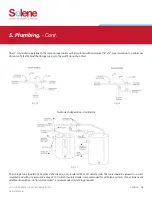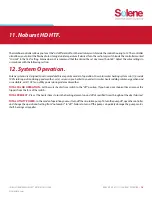
PIPE INSULATION | DIFFERENTIAL CONTROL & SENSORS.
-
11
6. Pipe Insulation.
7. Differential Control & Sensors.
INSTALLATION MANUAL SOLENE
®
HOT WATER SYSTEMS
©
2014 UMA Solar
The minimum ¾” collector loop cold supply and hot return lines must be well insulated with a high quality flexible closed cell
insulation to minimize heat loss. The wall thickness of the pipe insulation should not be less than ¾”. A 1”- wall thickness is required
in all areas prone to annual hard freeze conditions. When it comes to pipe insulation the rule is simple: thicker is better. The specified
insulation material is Armaflex or equal.
To the extent possible, slide the insulation material over the pipe without cutting or taping. All butt joints must be sealed with
contact adhesive. The use of rigid polyethylene pipe insulation is prohibited.
All outdoor insulation should be protected from moisture and ultraviolet deterioration by either paint or foil tape. All copper piping
should be properly supported, approximately every 6’. The support clamps should be installed in a way as to not compress the pipe
insulation.
The Differential Control has a high limit storage setting that can be adjusted from 110°F to 200°F and is typically preset to 140°F. It
is very important to verify that the high limit is set and engaged per manufacturer’s instructions. This will prevent “overheating” in
cases of high solar irradiation and low water usage. Please refer to the installation instructions of the controller manufacturer for all
items relating to controller connections, settings, sensor location and sensor wiring.
In order to properly mount the heat sensor on the solar storage tank follow these steps:
The roof sensor should be mounted to the outlet of the collector. A stainless steel hose clamp should be used. The entire outlet should
be completely wrapped with insulating tape so that the sensor is insulated from the outside air.
Remove the round cover located at the bottom front of the tank.
Attach sensor to storage tank.
Attach a length of sensor wire to sensor leads and the other end to the controller terminals marked tank or water.
1.
2.
3.














































